“You live your life at
the time you live it -- you don't have much of
an overview when what's happening to you is
still happening.”
John Irving |
|
| |
| Toastmasters Pathways |
| Six Paths to Personal and Professional
Growth |
“You live your life at the time you live it -- you don't have
much of an overview when what's happening to you is still
happening.”
― John
Irving, In
One Person |
| - |
| View other paths in
Pathways |
| (Click icon to view another path) |
| - |
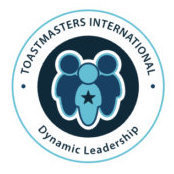 |
 |
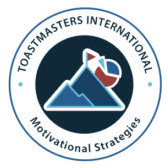 |
 |
 |
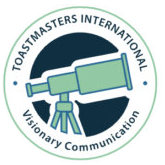 |
Dynamic
Leadership |
Engaging
Humor |
Motivational
Strategies |
Presentation
Mastery |
Persuasive
Influence |
Visionary
Communication |
| |
|
|
|
|
|
|
|
| |
| Toastmasters’ Pathways learning experience
offers members a modern, flexible way to build communication and
leadership skills. Each Path focuses on a distinct set of
competencies, allowing members to tailor their learning to their
personal goals. |
| |
| Our Pathways enhancements
will add new requirements to existing paths with the goal of
contributing to the overall success and quality of your club |
| |
| With these enhancements, members will be
required to complete meeting roles and give presentations from
the Toastmasters Education Series as they progress through their
path. Specific updates related to the rollout will be shared on
the
Pathways Updates page
as information becomes available. |
| |
| In response to feedback from members and
club officers like you, members will now be required to fulfill
specific meeting roles at every level of Pathways. Meeting roles
are essential to keeping clubs running and are an invaluable way
to practice communication and leadership skills. Members will
begin with simpler roles, such as Table Topics Speaker. As they
progress to higher levels of their path, they’ll move on to more
challenging ones, such as Toastmaster of the Day. |
| |
| As a club officer, there are a few important things to keep in mind: |
| |
| 1. Each member must complete their
required meeting roles while working in the relevant level in
order to receive credit. For example, they cannot fulfill a role
while in Level 1 and receive credit for the role in Level 3. |
| |
| 2. These requirements are a minimum level
of participation needed to complete each level. Members should
still be encouraged to participate in meeting roles outside of
these requirements according to their skills, their goals, and
the needs of the club. |
| |
| 3. Members can record their meeting roles
in their Profile on Base Camp. Near the bottom of a member’s
profile, there is a section titled “Meeting Roles” where
individuals can input their roles and the dates they fulfilled
them. These will be visible to you as a Base Camp manager when
viewing the member’s profile |
| |
| Let's begin with a quick review. Pathways currently offers six paths, as shown in the table below. |
| |
| Currently each path consists of five
Levels, with a number of project per level as shown below. The
first chart shows Pathways as it in pre-October 2025. |
| |
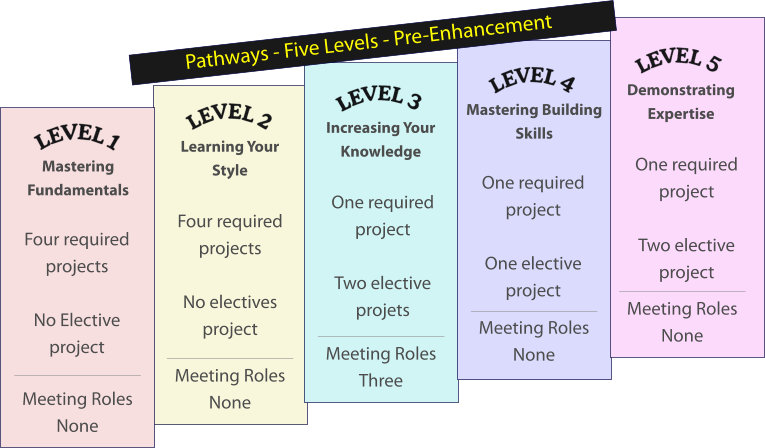 |
| Members will now be required to fulfill
specific meeting roles at every level of Pathways. Meeting roles
are essential to keeping clubs running and are an invaluable way
to practice communication and leadership skills. A simple
overview of the new Pathways structure is shown below,
identifying the new areas brought about by thee enhancements: |
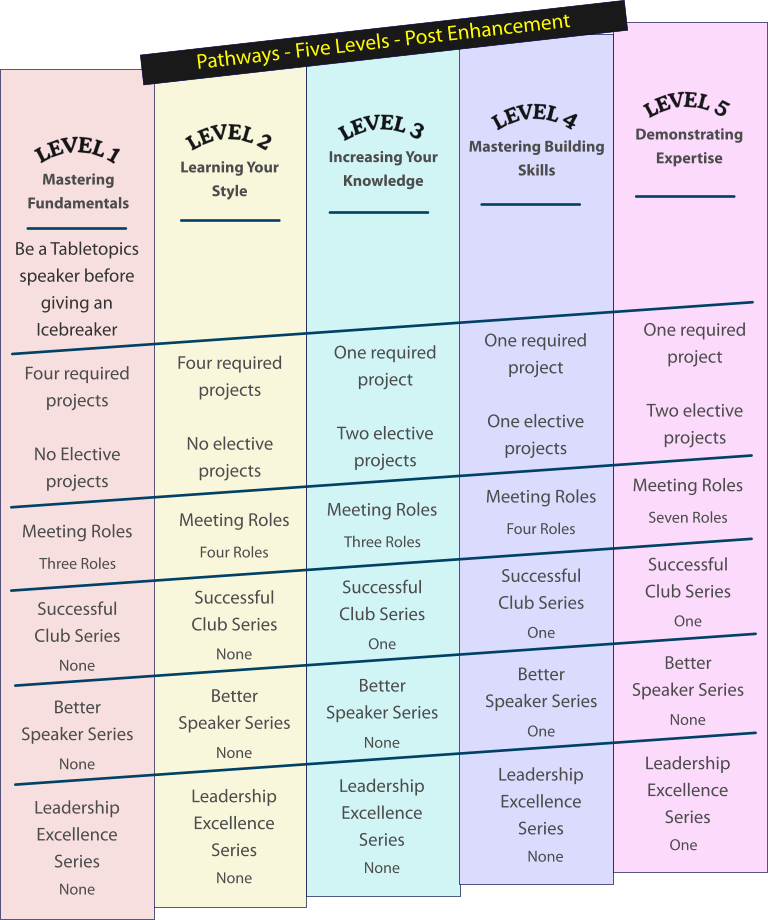 |
| |
| Here are the six paths currently offered (Click Icon below for more details): |
| |

|
| Dynamic Leadership |
|
| |
|
Develop skills in negotiation, conflict resolution, and leading through change. Great for anyone who wants to inspire others and guide teams effectively.
|
|
| |

|
Persuasive Influence |
| |
| Build the skills to motivate others, shape opinions, and lead with empathy and impact — essential for any influencer or leader. |
| | |

|
Engaging Humor |
| Discover how to add humor naturally to speeches and presentations. Perfect for connecting with audiences through authenticity and laughter. |
| | |

|
Presentation Mastery |
| |
| Develop professional-level speaking and storytelling skills, learning how to command a room and deliver messages that stick. |
| | |

|
Motivational Strategies |
| |
| Explore ways to inspire action, foster teamwork, and encourage others to reach their full potential. |
| | |

|
Visionary Communication |
| |
| Hone your ability to craft and share a compelling vision, communicate purpose, and rally people around shared goals. |
|
| |
1. Dynamic Leadership: View Here.
|
| Focus / Strengths: |
Developing strategic leadership, managing change, navigating conflict, adapting leadership style to context; Great for people who expect to lead teams, manage transitions, or take on leadership roles in organizations.
|
|
Unique / Distinguishing Projects (Levels 3-5): |
Negotiate the Best Outcome (Level 3) — understanding negotiation styles and strategy; Manage Change (Level 4) — planning change initiatives, dealing with resistance, communicating transitions. Lead in Any Situation (Level 5) — serve in a leadership role (6+ months), get peer feedback, present a speech reflecting on your experience; Reflect on Your Path — summarizing your journey, lessons learned
|
|
When to Pick It |
If your goals include leading change in your organization, handling conflict, improving how you lead groups (not just speaking), this path gives you a lot of content in that domain.
|
|
| 2. Engaging Humor:
View Here. |
| Focus / Strengths: |
Building skills in crafting and delivering speeches that incorporate humor effectively. Learning when humor is appropriate, handling challenging or impromptu speaking with humor, and maintaining audience engagement through wit.
|
| Unique / Distinguishing Projects: |
|
|
The Power of Humor in an Impromptu Speech (Level 4) — using humor under pressure, in Table Topics type settings; Deliver Your Message With Humor (Level 5) — culminating with a longer humorous speech that integrates what you’ve learned.
|
| When to Pick It: |
| If you enjoy using humor (or want to get better at it), want to be more entertaining or engaging in your talks, and want “fun” as a core element of your speaking style, this is a strong path. |
|
| |
| 3. Motivational Strategies:
View Here. |
| Focus / Strengths: |
Learning how to motivate, inspire, connect with people, and lead through influence rather than authority. Useful for leaders, coaches, managers, or anyone whose role involves energizing others and getting buy-in.
|
| Unique / Distinguishing Projects: |
Projects around motivation, connection, and leading small groups. Useful for leaders, coaches, managers, or anyone whose role involves energizing others and getting buy-in.
|
| When to Pick It: |
| If your role involves influencing without formal power, or inspiring people (teams, volunteers, peers) is central, this path is well suited. |
| |
|
| 4. Persuasive Influence:
View Here. |
| Focus / Strengths: |
Combining communication and leadership skills with negotiation, persuasion, and influence. Particularly useful in situations where you need to sway opinions or find compromise in challenging contexts.
|
| Unique / Distinguishing Projects: |
Emphasis on negotiating a positive outcome, managing conflict, influencing others in complex situations. Culminates in a High Performance Leadership project (you design a significant initiative).
|
| When to Pick It: |
| If your main goal is to become a strong public speaker, get better at crafting and delivering powerful speeches, and you aren’t as focused (at least initially) on leadership roles — this path gives a solid foundation. |
|
| |
| 5. Presentation Mastery:
View Here. |
| Focus / Strengths: |
Sharpening core speaking skills: structure, delivery, connecting with audiences, refining style More “speech-centric” than leadership-heavy.
|
| Unique / Distinguishing Projects: |
Projects tailored to how the audience perceives you, and how you can adapt and improve your delivery style. At Level 5, you deliver an extended speech that integrates your mastery of techniques.
|
|
When to Pick It:
If your main goal is to become a strong public speaker, get better at crafting and delivering powerful speeches, and you aren’t as focused (at least initially) on leadership roles — this path gives a solid foundation.
|
|
| 6. Visionary Communication:
View Here. |
| Focus / Strengths: |
Blending communication and strategy: planning how to communicate change, building a vision, influencing over time. Good for leaders who want to craft narrative, launch initiatives, or influence the bigger picture.
|
| Unique / Distinguishing Projects: |
Emphasis on long-term communication planning, managing change communication, and innovating solutions. Culminates in the development and launch of a long-term personal or professional vision.
|
|
When to Pick It:
If you see yourself in roles where you’ll present or drive vision, organizational change, or future initiatives, this path gives you tools to think and communicate at that level.
|
|
| |
| - |
| View this layout for all other paths in Pathways |
| (Click icon to view another path) |
| - |
 |
 |
 |
 |
 |
 |
Dynamic
Leadership |
Engaging
Humor |
Motivational
Strategies |
Presentation
Mastery |
Persuasive
Influence |
Visionary
Communication |
| |
|
|
|
|
|
|
|
|
|
| |
| - |
| See my view of each Path in Pathways |
| (Click icon to view another path) |
| - |
 |
 |
 |
 |
 |
 |
Dynamic
Leadership |
Engaging
Humor |
Motivational
Strategies |
Presentation
Mastery |
Persuasive
Influence |
Visionary
Communication |
| |
|
|
|
|
|
|
|
|
| |
| |
| |
| |
|
|


